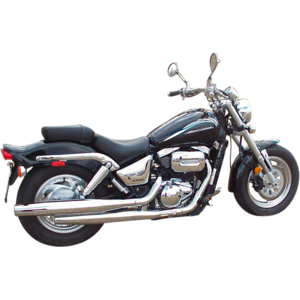Suzuki M 800 Intruder / VZ 800 Marauder (1996–2004): A Retrospective Ride Review
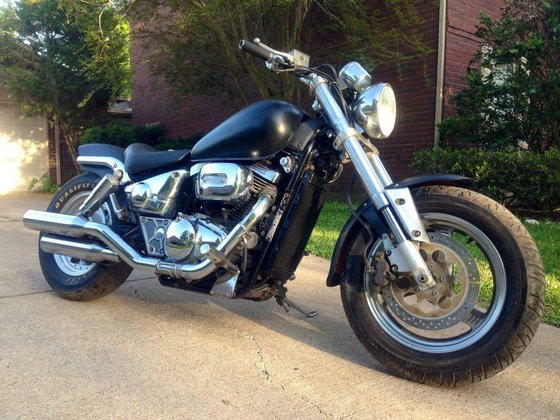
Introduction
The Suzuki M 800 Intruder, also marketed as the VZ 800 Marauder in later years, stands as a fascinating artifact of late-’90s cruiser design. Built between 1996 and 2004, this liquid-cooled V-twin aimed to blend accessible pricing with Suzuki’s signature “chopper-chic” aesthetic. While it never quite achieved the cult status of its Intruder 1400 sibling, this middleweight cruiser carved out a niche for riders seeking a balance of style, simplicity, and urban practicality. Let’s take a nostalgic spin through its legacy.
Design & Styling: Low-Slung Attitude
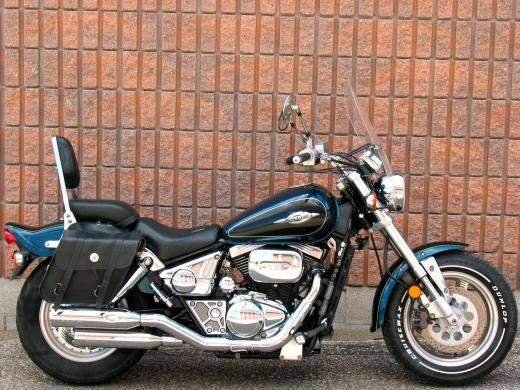
At first glance, the Intruder 800/Marauder demands attention with its aggressive stance and chrome-laden bodywork. The 45-degree V-twin engine dominates the frame, flanked by staggered exhaust pipes that wrap dramatically around the right side—a design choice that polarized critics but gave the bike a distinct identity.
Key styling elements:
- Inverted 41mm USD forks (a rarity in ’90s cruisers) for a modern, performance-oriented look.
- Cast aluminum wheels with a 16-inch front and 15-inch rear tire combo, wrapped in chunky rubber (130/90-16 front, 150/90-15 rear).
- Sculpted fuel tank (13L capacity) with metallic two-tone paint options like Black/Blue and Silver.
The riding position leans into classic cruiser ergonomics: pullback handlebars, mid-mounted pegs, and a 700mm seat height that even shorter riders found approachable. However, the thinly padded “wedge” seat drew ire for transforming 30-minute joyrides into endurance tests—a common complaint until Suzuki widened it in post-2002 models.
Engine & Performance: Jekyll & Hyde Personality
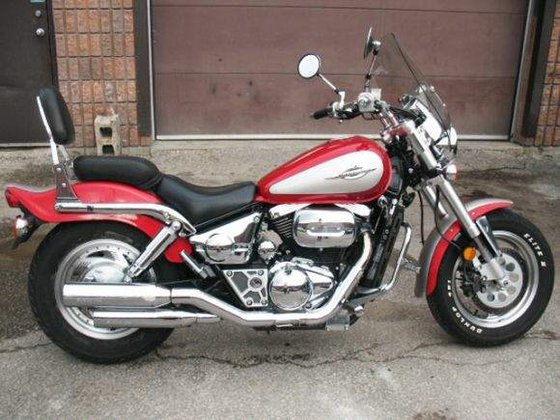
Powering the Intruder/Marauder is Suzuki’s 805cc SOHC V-twin, a liquid-cooled unit producing 50–53 HP and 62–66 Nm of torque. On paper, it promises lazy, low-end grunt perfect for boulevard cruising. Reality, however, reveals quirks:
- Carburetion Woes: The Mikuni BDS36 carburetor—paired with convoluted exhaust routing—creates a notorious flat spot around 2,500 RPM. Acceleration stumbles before recovering, a flaw riders learned to “roll through.”
- Chain vs. Shaft Drive: Early Intruders used a shaft drive, while Marauders switched to a chain for sharper throttle response. Both systems had trade-offs: shafts required less maintenance; chains offered better feel.
- Top Speed: Capable of 160–164 km/h (99–102 mph), though vibrations at highway speeds made sustained runs fatiguing.
The engine’s saving grace? Its Twin Swirl Combustion Chambers ensured smooth midrange power, making it surprisingly adept at overtaking in city traffic.
Ride & Handling: Compromises & Surprises
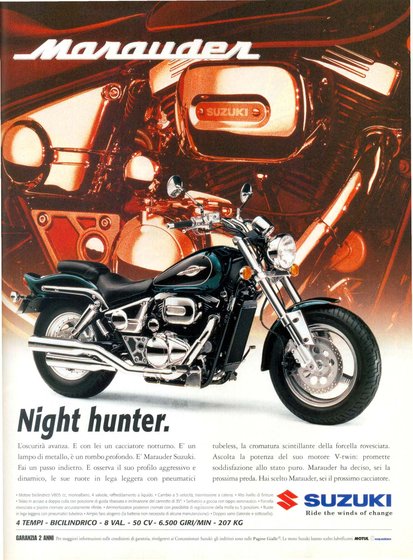
Suzuki’s chassis choices reflect the era’s cruiser priorities: stability over agility. The 1,645mm wheelbase and 207kg dry weight give it planted straight-line manners, but tight corners reveal limitations:
- Suspension: The inverted fork and 5-way adjustable rear shocks (preload only) handle bumps competently, albeit with a firm edge over potholes.
- Ground Clearance: Just 135mm (5.3 inches). Pegs scrape early, demanding cautious leans.
- Brakes: A single 310mm front disc (2-piston caliper) and rear drum provide adequate stopping power, though modern riders might crave ABS.
Where the Intruder/Marauder shines is low-speed maneuverability. The lightweight (by cruiser standards) frame and neutral steering make it a joy in parking lots and city grids.
Competition: Middleweight Cruiser Showdown
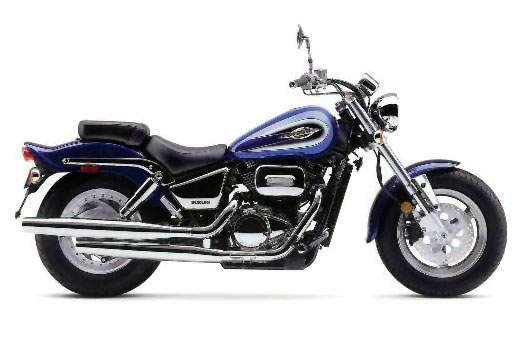
In the ’90s/early 2000s, the Intruder/Marauder faced fierce rivals:
| Model | Engine | Power | Torque | Weight | Key Differences |
|--------------------|--------------|-------|--------|--------|-----------------|
| Honda Shadow 750 | 745cc V-twin | 44 HP | 60 Nm | 228kg | Softer suspension, iconic “peanut” tank |
| Kawasaki Vulcan 800 | 805cc V-twin | 50 HP | 66 Nm | 220kg | Belt drive, plusher seat |
| Yamaha Virago 750 | 749cc V-twin | 55 HP | 58 Nm | 195kg | Lighter, air-cooled simplicity |
Suzuki’s Edge:
- Liquid cooling allowed consistent performance in traffic.
- Modern touches like inverted forks and digital ignition stood out in a retro-heavy segment.
Shortcomings:
- Cramped ergonomics vs. the Shadow’s rider-friendly layout.
- Rough-around-the-edges engine tuning compared to the Vulcan’s refinement.
Maintenance: Keeping the Intruder/Marauder Rolling
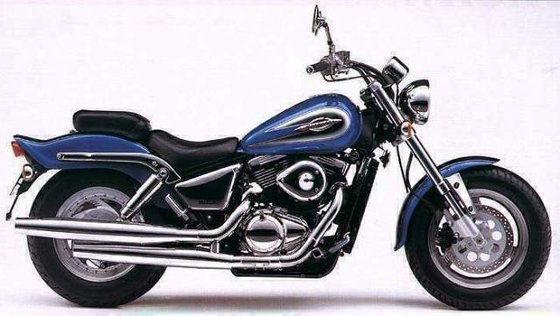
Owners praise these bikes for mechanical simplicity, but key upkeep areas demand attention:
- Valve Adjustments: Every 12,000 km. Requires shims (clearance: 0.08–0.13mm cold).
- Carburetor Tuning: Address the mid-RPM stumble with aftermarket jets (available at MOTOPARTS.store).
- Chain Care: Marauder models need regular lubrication—consider upgrading to a DID 530VX chain.
- Oil Changes: 2.1L of SAE 10W-40 every 5,000 km. Use Suzuki’s OEM filter (p/n 16510-14B00).
- Cooling System: Flush with ethylene glycol coolant every 2 years.
Pro Upgrades:
- Seat: Replace the stock saddle with a Corbin Gunfighter for all-day comfort.
- Exhaust: Slip-on mufflers (e.g., Vance & Hines Classic II) alleviate backpressure issues.
- Handlebars: 6-inch risers improve ergonomics for taller riders.
Conclusion: A Cult Classic in Waiting
The Suzuki M 800 Intruder/VZ 800 Marauder isn’t a perfect motorcycle—its carburetion quirks and firm seat see to that—but it embodies an era when Japanese cruisers dared to be different. Today, it’s a compelling used-buy for riders who value standout styling over outright comfort, especially with affordable aftermarket fixes available.
Whether you’re restoring a ’96 Intruder or hot-rodding a ’04 Marauder, MOTOPARTS.store has the upgrades to transform this underdog into your personalized pavement prowler. From performance air filters to retro LED taillights, make it yours—one wrench turn at a time.
Specifications sheet
| Engine | |
|---|---|
| Stroke: | Four-stroke |
| Max power: | 39 kW | 52.0 hp |
| Max torque: | 65 Nm |
| Fuel system: | Carburettor (Mikuni BDS36) |
| Max power @: | 6500 rpm |
| Displacement: | 805 ccm |
| Max torque @: | 5000 rpm |
| Bore x stroke: | 83.0 x 74.4 mm (3.3 x 2.9 in) |
| Configuration: | V |
| Cooling system: | Liquid |
| Compression ratio: | 10.0:1 |
| Number of cylinders: | 2 |
| Valves per cylinder: | 4 |
| Dimensions | |
|---|---|
| Wheelbase: | 1645 mm (64.8 in) |
| Dry weight: | 207 |
| Seat height: | 700 mm (27.6 in) |
| Overall width: | 750 mm (29.5 in) |
| Overall height: | 1110 mm (43.7 in) |
| Overall length: | 2365 mm (93.1 in) |
| Ground clearance: | 135 mm (5.3 in) |
| Fuel tank capacity: | 13 L (3.4 US gal) |
| Drivetrain | |
|---|---|
| Final drive: | chain |
| Chain length: | 116 |
| Transmission: | 5-speed |
| Rear sprocket: | 48 |
| Front sprocket: | 15 |
| Maintenance | |
|---|---|
| Engine oil: | 10W40 |
| Idle speed: | 1200 ± 100 RPM |
| Brake fluid: | DOT 4 |
| Spark plugs: | NGK DPR8EA-9 or NGK DPR8EIX-9 |
| Spark plug gap: | 0.9 |
| Coolant capacity: | 1.46 |
| Forks oil capacity: | 1.7 |
| Engine oil capacity: | 2.1 |
| Engine oil change interval: | Every 5000 km or 2 years, whichever comes first |
| Valve clearance (intake, cold): | 0.08–0.13 mm |
| Valve clearance check interval: | 24,000 km / 15,000 mi |
| Valve clearance (exhaust, cold): | 0.08–0.13 mm |
| Recommended tire pressure (rear): | 2.25 bar (33 psi) |
| Recommended tire pressure (front): | 2.0 bar (29 psi) |
| Chassis and Suspension | |
|---|---|
| Frame: | Steel cruiser |
| Rear tire: | 150/90-15 |
| Front tire: | 130/90-16 |
| Rear brakes: | Single drum |
| Front brakes: | Single 310 mm disc, 2-piston caliper |
| Rear suspension: | Swingarm, oil-damped, 5-way adjustable spring preload |
| Front suspension: | Inverted telescopic fork, coil spring, oil-damped |
| Rear wheel travel: | 102 mm (4.0 in) |
| Front wheel travel: | 140 mm (5.5 in) |



